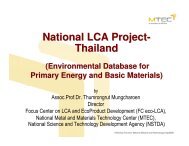ILCD Handbook: Framework and requirements for LCIA models and ...
ILCD Handbook: Framework and requirements for LCIA models and ...
ILCD Handbook: Framework and requirements for LCIA models and ...
Create successful ePaper yourself
Turn your PDF publications into a flip-book with our unique Google optimized e-Paper software.
<strong>ILCD</strong> <strong>H<strong>and</strong>book</strong>: <strong>Framework</strong> <strong>and</strong> <strong>requirements</strong> <strong>for</strong> <strong>LCIA</strong> <strong>models</strong> <strong>and</strong> indicators First edition<br />
1. VOCs or CO react with hydroxyl radical OH• in the troposphere <strong>and</strong> <strong>for</strong>m peroxy<br />
radicals, ROO•.<br />
2. The peroxy radicals oxidize NO to NO2.<br />
3. NO2 is split by sunlight with <strong>for</strong>mation of NO <strong>and</strong> release of oxygen atoms.<br />
4. Oxygen atoms react with molecular oxygen, O2, to <strong>for</strong>m ozone.<br />
Both VOCs <strong>and</strong> nitrogen oxides are there<strong>for</strong>e needed <strong>for</strong> the photochemical ozone<br />
<strong>for</strong>mation <strong>and</strong> should be covered by the characterisation <strong>models</strong>. The heterogeneous spatial<br />
distribution of VOC <strong>and</strong> NOx sources across Europe, <strong>and</strong> the hundreds of chemical species<br />
involved, makes the photochemical <strong>for</strong>mation of ozone on a regional scale highly non-linear<br />
<strong>and</strong> dynamic. It is influenced by meteorological conditions <strong>and</strong> interaction between the<br />
different VOCs – both from anthropogenic <strong>and</strong> natural sources, such as <strong>for</strong>ests.<br />
The complexity <strong>and</strong> the number of individual substances <strong>for</strong> which characterisation factors<br />
must be calculated leads to a need <strong>for</strong> simplification which is obtained in two different ways<br />
in the available characterisation <strong>models</strong>.<br />
1. The non-linear <strong>and</strong> dynamic behaviour is ignored in a model which represents one<br />
or more typical situations in terms of meteorology, atmospheric chemistry <strong>and</strong><br />
concomitant emissions of other air pollutants.<br />
2. The variation between individual VOCs is (largely) ignored <strong>and</strong> only a few<br />
substance-specific characterisation factors are calculated.<br />
The first approach is adopted in the <strong>models</strong> based on the POCP (Photochemical Ozone<br />
Creation Potential) or MIR (Maximum Incremental Reactivity) concept. Here individual<br />
characterisation factors are provided <strong>for</strong> many different VOCs. The second approach is<br />
adopted in regionally differentiated <strong>models</strong> which attempt to capture the non-linear nature of<br />
the ozone <strong>for</strong>mation with its spatially <strong>and</strong> temporally determined differences.<br />
Due to the complexity of the underlying chemical reaction schemes <strong>and</strong> the number of<br />
different substances which contribute to photochemical ozone <strong>for</strong>mation, a trade off exists<br />
between the degree of detail which can be applied in the fate modelling (including the<br />
support of spatially explicit modelling) <strong>and</strong> the degree of detail applied in the distinction of<br />
differences in substance characteristics <strong>for</strong> the individual VOCs.<br />
The variation in photochemical ozone <strong>for</strong>mation between substances is rather modest,<br />
except <strong>for</strong> halogenated hydrocarbons, CH4 <strong>and</strong> CO, which all have relatively low ozone<br />
<strong>for</strong>mation potentials. This is revealed by the POCP or MIR values applied <strong>for</strong> substance<br />
differentiation in several methods. The variation caused by spatial differentiation in the<br />
modelling of fate <strong>and</strong> exposure within Europe is considerably higher (Hauschild et al. 2006).<br />
Various studies including those by Andersson-Skjöld in the 1990s seemed to point at a<br />
weakness in the calculations of Photochemical Ozone Creating Potential (POCPs) per<strong>for</strong>med<br />
in the 1990s using highly detailed chemical mechanisms. The POCPs were generally<br />
obtained using very simplified Lagrangian transport <strong>models</strong>, using linear trajectories, <strong>and</strong> the<br />
results were thus strongly linked to the chemical regimes that the air parcels were passing in<br />
the per<strong>for</strong>med scenario calculations. Although the study of Derwent et al. (1998) was<br />
per<strong>for</strong>med using a highly detailed chemical mechanism, these new studies indicated that<br />
very different results might have been obtained <strong>for</strong> a different air parcel. It is thus considered<br />
preferable to simplify the model on the substance side rather than on the modelling of the<br />
dynamic <strong>and</strong> non-linear nature of the impact pathway.<br />
To ensure consistency with several other impact categories, the ideal midpoint indicator<br />
would be the time- <strong>and</strong> area-integrated concentration increase <strong>for</strong> ozone in the troposphere.<br />
This midpoint would cover impacts later in the environmental mechanism on the areas of<br />
protection (AoP) ‗Human Health‘ <strong>and</strong> ‗Natural Environment‘ (vegetation).<br />
4 Requirements <strong>for</strong> specific impact categories 52



